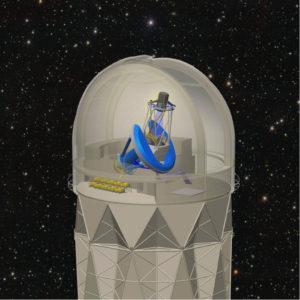3D Mapping Dark Energy to Understand the Universe
According to the traditional ideas of the Big Bang, there was a moment when nothing existed except for a tiny point, called a singularity. Something caused that singularity to become unstable and explode in such a way that everything was created. It’s an idea that can give a brain cramp to even the most brilliant of thinkers and the mechanics of this moment of creation, before which there was no space or time, has occupied the intellectual lives of several generations of philosophers, physicists, and laypeople since its development. As with any explosion, matter continues to move away from its source and it was originally theorized that eventually that matter would begin to slow its movement away from the center. However, data collected from the 1990s forward has indicated that rather than slowing down, the universe’s expansion is actually speeding up.

A view of the ProtoDESI setup during assembly at Berkeley Lab, with the underside of the robotic fiber-positioners visible at left. ProtoDESI is now installed at the 4-meter Mayall Telescope at Kitt Peak National Observatory near Tucson, Ariz. [Image: Paul Mueller/Berkeley Lab]
“Dark also describes well the many gaps in our understanding. No one can explain the dark energy’s origin, fundamental composition, or detailed properties – issues currently under intense investigation…But, even with the open questions, detailed observations using the Hubble Space Telescope and other earth-based observatories have reached consensus on the amount of dark energy [and] have concluded that the dark energy filling space contributes approximately 73 percent of the critical density.”

The first “petal” machined for the Dark Energy Spectroscopic Instrument (DESI) is shown in these photos. Ten of these petals, which together will hold 5,000 robots (like the one in the lower right photo)—each pointing a thin fiber-optic cable at separate sky objects—will be installed in DESI. [Image: Joe Silber/Berkeley Lab]

The Dark Energy Spectroscopic Instrument (DESI), shown in this illustration, will be mounted on the 4-meter Mayall telescope at Kitt Peak National Observatory near Tucson, Ariz. It will collect data on light from 35 million galaxies and quasars to make the biggest 3-D map of the universe ever. [Image: R. Lafever, J. Moustakas/DESI Collaboration]
“I like to think of the imaging surveys as building the 2D maps, while DESI adds the third dimension. The crucial third dimension allows us to measure how galaxies cluster together in space over the history of the universe.”
His point is reinforced by Risa Wechsler of the SLAC National Accelerator Laboratory at Stanford University and the co-spokesperson for DESI:
“DESI will be able to make a 3D map of the universe using an order of magnitude more redshifts than currently exist. This will allow us to probe the physics of the universe and discover the true nature of dark energy.”
With the stage of funding just triggered in this multi-phase project, the major components of this massive data gathering project will begin to be fabricated. One of those components is a pie-shaped section, called a petal, that will hold the cylindrical robots that will each point a fiber optic cable in a specific direction in order to collect light from a particular set of galaxies, stars, or quasars. This light collection will give scientists the ability to peer back in time, approximately 11 billion years worth of it. That doesn’t quite bring us to the moment of the big bang, estimated to have taken place 13.7 billion years ago, but its definitely far enough to begin to provide us information about the creation of everything, ever, everywhere. Discuss further in the 3D Sky Mapping forum over at 3DPB.com.
[Source/Images: Berkeley Lab]Subscribe to Our Email Newsletter
Stay up-to-date on all the latest news from the 3D printing industry and receive information and offers from third party vendors.
Print Services
Upload your 3D Models and get them printed quickly and efficiently.
You May Also Like
AMT Shakes Up 3D Printing Market with Affordable, High-Performance Post-Processing Consumables
Additive Manufacturing Technologies (AMT), a global leader in automated 3D printing post-processing, is launching a new line of consumables that promises to significantly reduce operational costs for additive manufacturing users....
The Bambu Lab 3D Printing Platform… or Trapdoor?
Bambu Lab began as a completely closed 3D printing system, where the printer, software, and materials all functioned well but were exclusively from the company itself. This approach mirrored Formlabs,...
2025 Renault 5 E-Tech Electric Is Latest Car with 3D Printed Accessories
Due to the required numbers, additive manufacturing (AM) has struggled to make significant inroads into vehicle interiors in meaningful numbers—at least as far as public knowledge is concerned. Typically an...
BMW Completes Project to Automate Plastic 3D Printing
After a three-year journey to efficiently scale polymer 3D printed part production, the POLYLINE project has concluded. This endeavor, headquartered at BMW’s Additive Manufacturing Campus, pooled the expertise of EOS,...






























